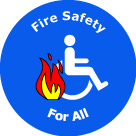2014-12-09: FireOx International, the Fire Engineering Division of Sustainable Design International Ltd., is very pleased and proud to present the following Global CSR (Corporate Social Responsibility) Event …
 9 & 10 April 2015 – Dublin Castle, Ireland
9 & 10 April 2015 – Dublin Castle, Ireland
‘Fire Safety for All’ in Buildings – Reboot & Reload !
[ www.fire-safety-for-all.eu ]
Co-Sponsored by CIB & RI-ICTA
Kindly supported by Fáilte Ireland
This will not be a polite gathering intended just for an Irish audience, or even for Europeans … this is a Global Event – a catalyst for Substantive Social Transformation everywhere !
Within the professional discipline of Fire Engineering … either a building is Fire Safe or it is not ; the design philosophy of the fire engineer is irrelevant. Similarly, now, we must begin to think and act in the simple terms of a building either being Accessible for All, or not. And if the building is accessible for all, does it tick all of the right accessibility boxes well, i.e. effectively ?
While building fire safety codes and standards exist in almost every country … guidelines relating to the Fire Safety of People with Activity Limitations – IF those guidelines exist at all – are technically inadequate, entirely tokenistic, blatantly discriminatory, and rarely implemented.
This is a very significant obstacle to Effective Building Accessibility everywhere !!
Accessibility is now understood to mean the full cycle of independent building use, in an equitable and dignified manner … and this term includes the approach, entry to and use of a building, egress during normal conditions and removal from the vicinity of the building … and, most importantly, evacuation during a fire incident to a ‘place of safety’ which is remote from the building. (ISO 21542 : 2011)
Cogently mandated in the United Nations Convention on the Rights of Persons with Disabilities (2006) … the CRPD’s principal aim is to ensure that the Built, Social, Economic and Virtual Environments are sufficiently ‘accessible’ to permit a vulnerable and major(!) population group in all of our societies to enjoy the fundamental freedoms and human rights described in the Universal Declaration of Human Rights (1948).
Refer to Preamble Paragraph (g) in the UN Convention …
‘ Emphasizing the importance of mainstreaming disability issues as an integral part of relevant strategies of sustainable development,’
and to … Article 3 (General Principles), Article 9 (Accessibility), Article 11 (Situations of Risk & Humanitarian Emergencies), Article 19 (Living Independently & Being Included in the Community), Article 20 (Personal Mobility), Article 24 (Education), Article 27 (Work & Employment), Article 31 (Statistics & Data Collection), Article 32 (International Co-Operation), and Article 33 (National Implementation & Monitoring).
The focus of this event, therefore, is Real Accessibility. In other words, Effective Accessibility for People with Activity Limitations (which includes people with disabilities, and children under the age of 5 years, frail older people, women in the later stages of pregnancy, and people with health conditions, etc.) … an accessibility which actually works well for all potential building users. And it is appropriate also, now, to introduce the concept of Monitoring and Targeting this ‘real’ accessibility … independently, i.e. by 3rd Parties !
It is time to Reboot this ridiculous, professionally negligent and obsolete old system … Reload with innovative and practical building design, construction, management and personal self-protection solutions … and Implement !
.
.
END
